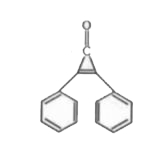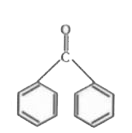Which has maximum enol content?
_CHE_E06_081_Q01.png)
_CHE_E06_081_Q02.png)
_CHE_E06_081_Q03.png)
_CHE_E06_081_Q04.png)
To determine which compound has the maximum enol content, we need to analyze the provided options. Enol content is influenced by factors such as the stability of the enol form, which can be enhanced by hydrogen bonding and resonance stabilization.
1. Identify the Compounds:
We have four options:
- Option A: CS3COCH2COCS3
- Option B: CH3COCH3
- Option C: CH3COCH2CONH2
- Option D: CH3COCH2COOC2H6
2. Analyze Each Compound for Enol Content:
- Option A: CS3COCH2COCS3
- This compound can form an enol due to the presence of two carbonyl groups and the potential for intermolecular hydrogen bonding and resonance stabilization.
- Option B: CH3COCH3
- This compound can also form an enol, but it lacks the additional stabilization factors present in Option A.
- Option C: CH3COCH2CONH2
- This compound has an amine group, which can participate in hydrogen bonding but does not have the same level of resonance stabilization as Option A.
- Option D: CH3COCH2COOC2H6
- This compound can form an enol, but again, it lacks the extensive stabilization seen in Option A.
3. Determine the Maximum Enol Content:
- After analyzing the compounds, it is clear that Option A has the maximum enol content due to the presence of two carbonyl groups that can stabilize the enol form through intermolecular hydrogen bonding and resonance.
Conclusion:
The compound with the maximum enol content is Option A: CS3COCH2COCS3.
We have four options:
- Option A: CS3COCH2COCS3
- Option B: CH3COCH3
- Option C: CH3COCH2CONH2
- Option D: CH3COCH2COOC2H6
- Option A: CS3COCH2COCS3
- This compound can form an enol due to the presence of two carbonyl groups and the potential for intermolecular hydrogen bonding and resonance stabilization.
- Option B: CH3COCH3
- This compound can also form an enol, but it lacks the additional stabilization factors present in Option A.
- Option C: CH3COCH2CONH2
- This compound has an amine group, which can participate in hydrogen bonding but does not have the same level of resonance stabilization as Option A.
- Option D: CH3COCH2COOC2H6
- This compound can form an enol, but again, it lacks the extensive stabilization seen in Option A.
- After analyzing the compounds, it is clear that Option A has the maximum enol content due to the presence of two carbonyl groups that can stabilize the enol form through intermolecular hydrogen bonding and resonance.
The compound with the maximum enol content is Option A: CS3COCH2COCS3.
Topper's Solved these Questions
Similar Questions
Knowledge Check
Which has maximum dipole moment ?
A B
B C
C D
D
Maximum enol content is in :
A B
B C
C D
D
Among the following compounds, which will give maximum enol content in solution :
AC6H5−O∣∣C−CH2−O∣∣C−C6H5BCH3−O∣∣C−CH2−O∣∣C−CH3CCH3−O∣∣C−CH2−CH2−CH3DCH3−O∣∣C−CH2−COOC2H5